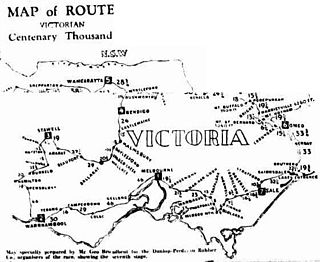Related Research Articles

Skiing in Victoria, Australia takes place in the Australian Alps located in the State of Victoria during the southern hemisphere winter. Victoria is the State with the greatest number of ski resorts in Australia. The highest peak in Victoria is Mount Bogong at 1986m. The first ski tow was constructed near Mount Buffalo in 1938. Victoria has a number of well developed ski resorts including Mount Hotham, Falls Creek and Mount Buller. Cross country skiing is popular in such national parks as Mount Buffalo National Park and Alpine National Park.

The Mount Buffalo National Park is a national park in the alpine region of Victoria, Australia. The 31,000-hectare (77,000-acre) national park is located approximately 350 kilometres (220 mi) northeast of Melbourne in the Australian Alps. Within the national park is Mount Buffalo, a moderately high mountain plateau, with an elevation of 1,723 metres (5,653 ft) above sea level.

The Falls Creek Alpine Resort is an alpine ski resort in the Hume region in northeastern Victoria, Australia. It is located in the Alpine National Park in the Victorian Alps, approximately 350 kilometres by road from Melbourne, with the nearest town being Mount Beauty, which is approximately 30 km (20 mi) away. The resort lies between an elevation of 1,500 and 1,830 m above sea level, with the highest lifted point at 1,780 m (5,840 ft). Skiing is possible on the nearby peak of Mount McKay at 1,842 m (6,043 ft), accessed by snowcat from the resort.

The Shire of Alpine is a local government area in the Hume region of Victoria, Australia, located in the north-east part of the state. It covers an area of 4,788 square kilometres (1,849 sq mi) and in August 2021 had a population of 13,235.

The Australian Alps are a mountain range in southeast Australia. The range comprises an interim Australian bioregion, and is the highest mountain range in Australia. The range straddles the borders of eastern Victoria, southeastern New South Wales, and the Australian Capital Territory. It contains Australia's only peaks exceeding 2,000 m (6,600 ft) in elevation, and is the only bioregion on the Australian mainland in which deep snow falls annually. The range comprises an area of 1,232,981 ha.

Mount Bogong,, located in the Alpine National Park and part of the Victorian Alps of the Great Dividing Range, is the highest mountain in Victoria, Australia, at 1,986 metres (6,516 ft) above sea level.

The Victorian Alps, also known locally as the High Country, is a large mountain system in the southeastern Australian state of Victoria. Occupying the majority of eastern Victoria, it is the southwestern half of the Australian Alps, the tallest portion of the Great Dividing Range. The Yarra and Dandenong Ranges, both sources of rivers and drinking waters for Melbourne, are branches of the Victorian Alps.

Bright is a town in northeastern Victoria, Australia, 319 metres above sea level at the southeastern end of the Ovens Valley. At the 2021 census, Bright had a population of 2,620. It is located in the Alpine Shire local government area.

Mount Beauty is a small town in north-eastern Victoria, Australia. The town lies alongside the Kiewa River, at the junction of the Kiewa Valley Highway and Bogong High Plains Road in the Alpine Shire local government area.

The Ovens River, a perennial river of the north-east Murray catchment, part of the Murray-Darling basin, is located in the Alpine and Hume regions of the Australian state of Victoria.

A cyclosportive, or often simply sportive, is a short to long distance, organised, mass-participation cycling event, typically held annually. The Italian term Gran Fondo is commonly used for these events in the United States, Australia and some other English-speaking countries.
Randonneuring is a long-distance cycling sport with its origins in audax cycling. In randonneuring, riders attempt courses of 200 km or more, passing through predetermined "controls" (checkpoints) every few tens of kilometres. Riders aim to complete the course within specified time limits, and receive equal recognition regardless of their finishing order. Riders may travel in groups or alone as they wish, and are expected to be self-sufficient between controls. A randonneuring event is called a randonnée or brevet, and a rider who has completed a 200 km event is called a randonneur. The international governing body for randonneuring is Audax Club Parisien (ACP), which works with other randonneuring organisations worldwide through Les Randonneurs Mondiaux (RM). Randonneuring is popular in France, and has a following in the Netherlands, Belgium, the United Kingdom, Italy, Australia, the United States, Canada, Brazil, Ireland, India, Indonesia, Korea, Japan and Malaysia.

The Bogong High Plains, part of the Victorian Alps of the Great Dividing Range, are a section of plains located in the Alpine National Park in the Australian state of Victoria and are situated south of Mount Bogong.

The Eastern Victorian alpine bushfires were a series of bushfires in 2003 that burnt in the Alpine National Park and Mount Buffalo National Park in north-eastern Victoria, Australia. The bushfire started with eighty-seven fires that were started by lightning in the north east of Victoria on 8 January 2003. Eight of these fires were unable to be contained and joined to form the largest fire in Victoria since the 1939 "Black Friday" bushfires.

Audax Australia Cycling Club runs cycling events under the auspices of Audax Club Parisien (ACP) and Union des Audax Français (UAF). Rides are normally from 50 km to 1200 km in distance and operate throughout Australia. The club also has a list of long distance rides that can be ridden at any time called raids.

Skiing in Australia takes place in the Australian Alps in the states of New South Wales, Victoria and the Australian Capital Territory as well as in the mountains of the island state Tasmania, during the Southern Hemisphere winter.

The Buckland River, a perennial river of the North-East Murray catchment of the Murray-Darling basin, is located in the Alpine region of Victoria, Australia. It flows from the eastern slopes of the Buffalo Range in the Australian Alps, joining with the Ovens River at Porepunkah.
The Peaks Challenge Falls Creek is a challenging cycling event held in the Australian Alps region of Victoria in March each year.

Mountain biking in Australia is a mix of dedicated mountain bike parks, ski resorts with mountain bike facilities, and other parks that have become popular with mountain bikers despite lacking dedicated facilities. The peak body for the sport is Mountain Bike Australia (MTBA).

The Centenary 1000 cycling race was a one-week road bicycle race over seven stages covering 1,102 miles (1,773 km). The race was run in 1934 as part of the celebrations of the Centenary of Victoria. The race was originally conceived along the lines of the Dunlop Grand Prix, won by Hubert Opperman then aged 23, by 1h 20' and the concept for the race was covering 1,000 miles (1,600 km) with prizes exceeding £1,000, including a climb over Mount Hotham.
References
- ↑ "O2 Events – O2 Events" . Retrieved 9 January 2020.
- ↑ "Alpine Classic Announcement". audax.org.au. Archived from the original on 4 September 2018. Retrieved 9 January 2020.
- ↑ Hanslip, Michael (July 2008), "Training for the Alpine Classic, episode three", Bicycling Australia , no. 152, pp. 128–131
- 1 2 "Alpine Classic – Alpine Classic".
- ↑ Annear, Peter (1986), Alpine Classic - The Original Alpine Classic Story, Audax Australia, retrieved 9 June 2008
- ↑ Tonkin, Alan (Winter 2009), "Announcing the Alpine Classic Extreme", Checkpoint , no. 40, p. 5
- ↑ "Alpine Classic – Alpine Classic".
- ↑ https://www.alpineclassic.com.au/images/stories/faq%20fires%20etc.pdf%5B%5D
- ↑ "Alpine Classic – Alpine Classic" . Retrieved 9 January 2020.
- ↑ Emergency Management Victoria, State Government of Victoria. "State of Disaster declared in Victoria". www.emv.vic.gov.au. Retrieved 9 January 2020.
- ↑ "Alpine Classic – O2 Events" . Retrieved 13 May 2024.
- ↑ Lamont, Matthew; Axelsen, Megan; Faulks, Pam (June 2008), Outcomes of the 2008 Audax Alpine Classic participant (PDF), Southern Cross University; University of Queensland; University of Canberra, p. 29, archived from the original (PDF) on 21 July 2008